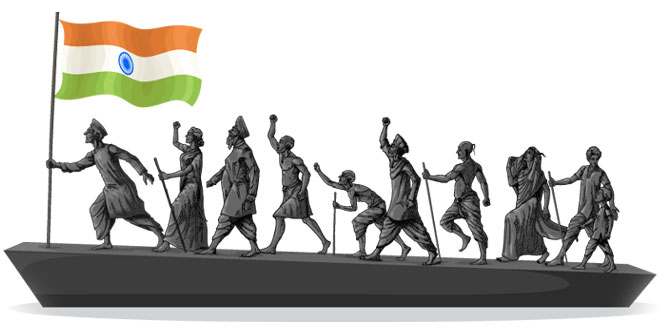Question: Why did Gandhiji decide to launch a nation wide ‘Satyagraha’ against the proposed Rowlatt Act 1919? Explain any three reasons. Or What was the Rowlatt Act? How it affected the National Movement?
Answer:
- Rowlatt Act was passed through the Imperial Legislative Council on a report of the Sedition Committee, headed by Justice Rowlatt.
- It was the black act which gave the government and the police to repress political activities, and allowed detention of political prisoners without tried for two years.
- The Act was passed despite the united opposition of the Indian members of the Council.
This Act became one of the factors due to which Gandhiji launched Non-Cooperation Movement.
Question: What were the three local issues in which Gandhiji experimented his technique of Satyagraha during the years 1917-1918? How were these issues resolved?
Answer: The three local issues were Champaran satyagraha ; Kheda satyagraha and Ahmedabad satyagraha.
- Champaran Satyagraha: In the first experiment indigo farmers were encouraged to raise their voice against the oppressive policies of the British. Their demands were sanctioned.
- Kheda Satyagraha: The second experiment was for the farmers who were unable to pay the revenue because of famine and plague epidemic. The recovery was waived off.
- Ahmedabad Satyagraha: The third was for the mill workers who were protesting for better wages. The British had to increase the wages along with reforms in working conditions.
Question: What was Rowlatt Act? How did the Indians show their disapproval towards this Act?
Answer: Rowlatt Act was an oppressive act introduced by the British Government in 1919. It gave the Government enormous powers to repress political activities and allowed detention of political prisoners without trial for two years. Indian DisapprovalMahatma Gandhi reacted sharply and decided to launch a non violent civil disobedience against such unjust law.Rallies were organised in various cities, workers went on strike in railways, workshops and shops closed down.Peaceful protest meeting were organised at Jallianwala Bagh-Amritsar.
Question: Who launched the Khilafat Movement? Why was the Movement launched?
Answer: Khilafat movement was a united struggle launched by Muhammed Ali and Shaukat Ali with the cooperation of Mahatma Gandhi. The First World War ended with the defeat of Ottoman Turkey. There were rumours that a harsh peace treaty was going to be imposed on the Ottoman emperor, the spiritual head of the Islam world. The Sultan was deprived of real authority even over those territories which were left under his control. This angered the Muslims in India. To defend the powers of Khalifa and to avert harsh peace treaty to be imposed on the Ottoman empire the Khilafat Committee was formed in 1919 in Bombay.
Question: Why Gandhiji supported the Khilafat Movement?
Answer:
- As the Rowlatt Satyagraha was limited to cities and towns Gandhiji felt the need to launch a more broad based movement in India. But he was certain that no such movement could be organised without bringing the Hindus and Muslims close together. So he took up the Khilafat issue.
- A new generation of Muslim leaders like the Ali brothers, Muhammed Ali and Shaukat Ali, began discussing with Mahatma Gandhi about the possibility of a united mass action on the issue. Gandhiji saw this as an opportunity to bring the Muslims under the umbrella of a unified national movement.
Question: Mention three main proposals with reference to the Non-Cooperation Movement as suggested by Mahatma Gandhi. Or Gandhiji proposed that the Non-Cooperation should unfold in stages. Explain.
Answer: The Non-Cooperation had two aspects, i.e., one relating to the struggle and the other relating to the norms of conduct and constructive work. Gandhiji proposed that the movement should unfold in the following stages:
- Surrender of titles, honors and honorary posts,
- Boycott of Legislative Councils,
- Boycott of law courts by the lawyers,
- Boycott of Government schools and colleges, and withdrawal of children from these schools and colleges.
- Boycott of British goods, To get a popular support for the movement, Mahatma Gandhi and Shaukat Ali toured extensively throughout India.
Question: Why was the Non-Cooperation Movement launched by Gandhiji?
Answer:
- After returning from Africa in 1915 Gandhiji launched some local satyagraha’s but he was looking for an opportunity to launch a national level movement against the Britishers.
- The Non-Cooperation Movement was launched by Gandhiji to support the Khilafat
- It was also launched against Rowlatt Act and the Jallianwala Bagh incident.
- Gandhiji merged the Khilafat Movement with the Non-cooperation Movement to bring the Muslims under the umbrella of a unified national movement.
 Class Notes NCERT Solutions for CBSE Students
Class Notes NCERT Solutions for CBSE Students





